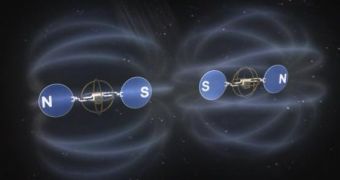Many space missions today cannot be carried out mostly because the involved spacecrafts would have to fly in a precise formation, such as NASA's Terrestrial Planet Finder mission or the Laser Interferometer Space Antenna, which is supposed to detect distortions in the matter of space-time known as gravitational waves. The problem is that in order for a fleet of spacecrafts to keep in formation, they would have to be positioned with the help of jet thrusters that would also have to maintain relative position.
This ultimately translates into continuous fuel consumption and if we take in consideration that the life of satellites is generally related to the amount of fuel carried on board, things seem to unfold a little bit more clearly. A couple of researchers from MIT's Space Systems Laboratory are now proposing a method to keep spacecrafts in close formation by using magnetic fields generated through superconducting magnets carried on board.
Unlike thruster fuel, in space electric energy is limitless, as long as you have a powerful source of light such as the Sun. Light is converted through the solar array panels carried by the spacecrafts and turned into electric energy. Theoretically a spacecraft working on solar power alone would have an infinite life. The magnetic fields generated by each individual spacecraft could be easily tuned so as to attract and repel each other, in order to maintain them at a required distance.
Testbed
The system is already being tested in MIT's Space Systems Laboratory by a team of researchers led by David Miller. In order to simulate weightless conditions, the test spacecrafts generate jets of air, which enables them to hover frictionlessly on a glass table. Relative position between individual vehicles is maintained by generating tunable magnetic fields with the help of superconducting coils.
"The biggest advantage is that you have no fuel that can run out. The magnetic coils work purely on electrical energy, which you can generate through solar arrays that point at the Sun", explains Miller.
Superconductivity
The sole problem that needs to be solved now is building the appropriate superconductive devices - high temperature superconducting materials, to work at a temperature of at least -196 degrees Celsius. The cooling system on the other hand can be resolved much easier by using insulation and electrically powered cooling systems.
Alternatively, the electromagnetic fields generated by the coils could easily interfere with the electronics on board the spacecrafts, says Jet Propulsion Laboratory researcher Fred Hadaegh. On the other hand, in space magnetic fields don't need to be that strong, in fact they could be even weaker than on Earth, and sensitive equipment would be wrapped in magnetic field shields made out of nickel-iron.
But by protecting some equipment with shields, other sensitive equipment such as cameras or antennas would become useless. Miller says that this can be countered by using secondary coils that would cancel the magnetic field generated by the main ones. And then there is Earth's naturally occurring magnetic field that will interact with the one generated by the spacecrafts, only to set them spinning.
JAXA researcher Shin-ichiro Sakai believes this problem can be solved by simply alternating the polarity of the magnets every few minutes, to counteract the spin momentum and keep the spacecrafts in place.
In 2006, NASA's Terrestrial Planet Finder mission was postponed indefinitely as a result of the lack of a formation flight technology, although the team responsible for the development of the mission had also tested the EMFF system proposed by Miller. "As a technologist, I get extremely excited about seeing new technology advances, so I welcome any type of breakthrough ideas", said Hadaegh.
The Terrestrial Planet Finder mission could instead be placed in an area of space where the gravitational field generated by the Sun is balanced by that of Earth and it would in fact require very little fuel to maintain formation. The EMFF system still needs to resolve its shielding problems, though.

 14 DAY TRIAL //
14 DAY TRIAL //